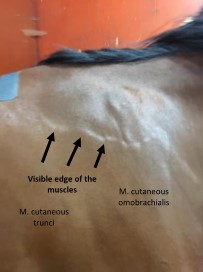… is the title of a children’s book which I loved to read. (Google for it, it’s really funny).
You all may have seen how a horse gets rid of an annoying fly or other insect. The horse does it by small contractions of the skin, which seem to happen without any further attention of the horse. The twitch is elicited by the panniculus reflex, activating a thin layer of muscles just under the skin. The reflex is well known and has been described in the literature as the Cutaneous Trunci Muscle (CTM) reflex. It is used in veterinary medicine for diagnostics. The CTM can easily be elicited by moving the fingers lateral from the back spine from the ilial crests cranially until a contraction occurs.
But which are the muscles we want to look at our horse?
Budras et al. as well as Sisson and Grossman have described in the horse several muscles of the skin, including the m. cutaneous omobrachialis, m. cutaneous trunci, m. cutaneous fasciae, and m. cutaneous colli. Note: m. stands for “musculus”.
M. cutaneous colli and m. cutaneous are the smallest of the muscles. M. cutaneous colli covers the caudoventral part of the neck, starting from the manubrium sterni and the cervical fascia and ascends in V-shape (see Figure below). It attaches partly on the m. cleidomastoideus.
The two largest muscles are m. cutaneous trunci and m. cutaneous omobrachialis. M. cutaneous omobrachialis covers the shoulder and arms and merges caudally with the m. cutaneous trunci, which extends from the area of the olecranon to the withers and caudally to the level of the thigh. The muscle then continues in a large fascia ventral-caudal (see Figure 1 below, modified after Budras et al. by CPR). The superficial trunk fascia encloses musculus cutaneous trunci.

Sometimes the edges of these muscles are visible as a line underneath the skin. Those lines differ from horse to horse, just as our fingerprints are individually different and unique for us. They are not always visible. However, you do not have be worried if you detect them, there is no need to worry, it is not an indication for an inflammation or other “problems”. Pärnilla Andreazon kindly provided me a picture where you can beautifully see the m. cutaneous omobrachialis and part of the m. cutaneous trunci. (Image below, marks by KWD)

But how does the horse get rid of flies and other insects that are out of range for the muscles? Well, there it will use his tail, bits them away or uses his legs/hooves. As you have seen it also many times. By this the horse can often show how flexible and agile it can move if they have to.
© Copyright by Hands for Horses Sweden, Dr. Karen Wild. All rights reserved by Hands for Horses Sweden; sharing is welcome but please respect the copyright